Related Research Articles

Kozhikode, also known in English as Calicut, is a city along the Malabar Coast in the state of Kerala in India. It has a corporation limit population of 609,224 and a metropolitan population of more than 2 million, making it the second most populous metropolitan area in Kerala and the 19th largest in India. Kozhikode is classified as a Tier 2 city by the Government of India.

The history of southern India covers a span of over four thousand years during which the region saw the rise and fall of a number of dynasties and empires.
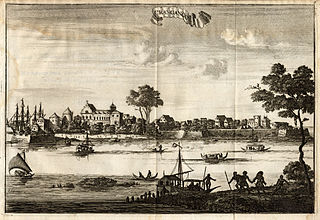
Kodungallur is a historically significant town situated on the banks of river Periyar on the Malabar Coast in Thrissur district of Kerala, India. It is 29 kilometres (18 mi) north of Kochi (Cochin) by National Highway 66 and 38 km (24 mi) from Thrissur. Kodungallur, being a port city at the northern end of the Kerala lagoons, was a strategic entry point for the naval fleets to the extensive Kerala backwaters. It was here that one of Jesus's disciples, St. Thomas reached during 1st century AD to preach Christianity.

Mappila Muslim, in general, is a member of the Muslim community of same name found predominantly in Kerala and Lakshadweep Islands, in southern India. Muslims of Kerala make up 26.56% of the population of the state (2011), and as a religious group they are the second largest group after Hindus (54.73%). Mappilas share the common language of Malayalam with the other religious communities of Kerala.

Kunjali Marakkar was the title inherited by the Admiral of the fleet of the Samoothiri / Zamorin, the king of Kozhikode / Calicut, in present-day Kerala, India. There were four Marakkars whose war tactics defended against the Portuguese invasion from 1520 to 1600. The Kunjali Marakkars are credited with organizing the first naval defense of the Indian coast.
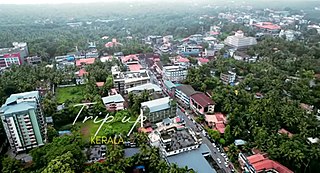
Vatakara,, , French: Bargaret, is a Municipality, Taluk and a major town in the Kozhikode district of Kerala state, India. The municipality of Vatakara covers an area of 23.33 km2 (9.01 sq mi) and is bordered by Mahé to the north and Payyoli to the south. It is the headquarters of Vatakara taluk, which consists of 22 panchayats. During the reign of the Kolathiris and Zamorins, Vatakara was known as Kadathanadu. During the British Raj, it was part of the North Malabar region of Malabar District in the state of Madras. The historic Lokanarkavu temple, made famous by the Vadakkan Pattukal, is situated in Vatakara. A new tardigrade species collected from Vadakara coast has been named after Kerala State; Stygarctus keralensis.

Ponnani is a municipality in Ponnani Taluk, Malappuram District, in the state of Kerala, India. It serves as the administrative center of the Taluk and Block Panchayat of the same name. It is situated at the estuary of Bharatappuzha, on its southern bank, and is bounded by the Arabian Sea on the west and a series of brackish lagoons in the south.

Malabar District, also known as Malayalam District, was an administrative district on the southwestern Malabar Coast of Bombay Presidency (1792–1800), Madras Presidency (1800–1937), Madras Province (1937–1950) and finally, Madras State (1950–1956) in India. It was the most populous and the third-largest district in the erstwhile Madras State. The historic town of Calicut was the admisnitrative headquarters of this district.
The term Kerala was first epigraphically recorded as Cheras (Keralaputra) in a 3rd-century BCE rock inscription by the Mauryan emperor Ashoka of Magadha. It was mentioned as one of four independent kingdoms in southern India during Ashoka's time, the others being the Cholas, Pandyas and Satyaputras. The Cheras transformed Kerala into an international trade centre by establishing trade relations across the Arabian Sea with all major Mediterranean and Red Sea ports as well those of Eastern Africa and the Far East. The dominion of Cheras was located in one of the key routes of the ancient Indian Ocean trade. The early Cheras collapsed after repeated attacks from the neighboring Cholas and Rashtrakutas.
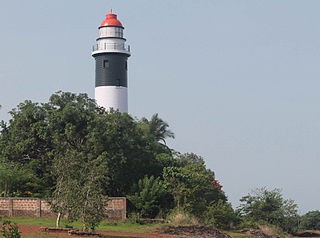
Koyilandy is a major town municipality and a taluk in Kozhikode district, Kerala on the Malabar Coast. The historical town is located right in the middle of the coast of Kozhikode district, between Kozhikode (Calicut) and Kannur, on National Highway 66.

Tanur is a coastal town, a municipality, and a block located in Tirur Taluk, Malappuram district, Kerala, India. It is located on the Malabar Coast, 9 kilometres (5.6 mi) north of Tirur and 9 kilometres south of Parappanangadi. It is the 17th-most populated municipality in the state, the fourth-most populated municipality in the district, and the second-most densely populated municipality in Malappuram district, having about 3,568 residents per square kilometre as of the year 2011.
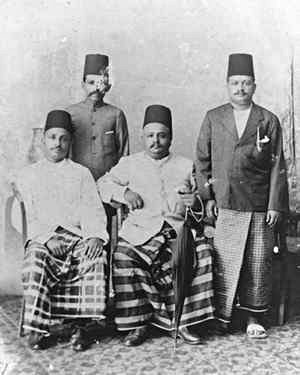
Sri Lankan Moors are an ethnic minority group in Sri Lanka, comprising 9.3% of the country's total population. Most of them are native speakers of the Tamil language. The majority of Moors who are not native to the North and East also speak Sinhalese as a second language. They are predominantly followers of Islam. The Sri Lankan Muslim community is mostly divided between Sri Lankan Moors, Indian Moors, Sri Lankan Malays and Sri Lankan Bohras. These groups are differentiated by lineage, language, history, culture and traditions. Finlay McDonald has noted in the second paragraph of his article on Sri Lankan Muslims in New Zealand's conversation newspaper, published on April 23, 2019, the following observation, "Linguistically, most have Tamil as their mother tongue, often leading them to be categorised as part of the island’s Tamil minority, alongside Hindus and Christians. There are, however,Muslims who speak the majority Sinhala language."

Islam arrived in Kerala, the Malayalam-speaking region in the south-western tip of India, through Middle Eastern merchants. The Indian coast has an ancient relation with West Asia and the Middle East, even during the pre-Islamic period.
Tuhfat al-Mujahidin fi ba‘d Akhbar al-Burtughaliyin is a historical work by Zainuddin Makhdoom II on the struggle between the Mappila Muslims of Malabar and South Canara and Portuguese colonial forces in the 16th century. It is the first historical work of Kerala to be authored by a Keralite. The book describes the resistance put up by the navy of Kunjali Marakkar alongside the Zamorin of Calicut from 1498 to 1583 against Portuguese attempts to colonize the Malabar coast. Along with chronological events of the era, the book also provides an analysis of the events, as well as the lifestyle, customs and family structure of the people of the time.
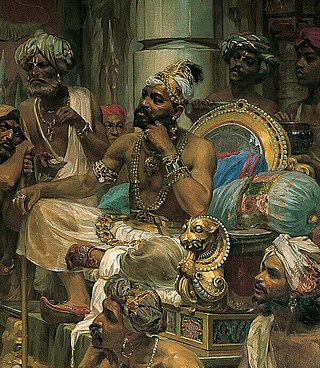
The Samoothiri was the title of the erstwhile ruler and monarch of the Kingdom of Kozhikode (Calicut) in the South Malabar region of India. Originating from the former feudal kingdom of Nediyiruppu Swaroopam, the Samoothiris and their vassal kings from Nilambur Kovilakam established Calicut as one of the most important trading ports on the southwest coast of India. At the peak of their reign, they ruled over a region extending from Kozhikode Kollam to the forested borders of Panthalayini Kollam (Koyilandy). The Samoothiris belonged to the Eradi subcaste of the Samantan community of colonial Kerala, and were originally the ruling chiefs of Eranad. The final Zamorin of Calicut committed suicide by setting fire to his palace and burning himself alive inside it, upon learning that Hyder Ali had captured the neighboring country of Chirackal in Kannur.

Religion in Kerala is diverse. According to 2011 census of India figures, 54.73% of Kerala's population are Hindus, 26.56% are Muslims, 18.38% are Christians, and the remaining 0.33% follow other religions or have no religion. As of 2020, Hindus, Muslims, Christians and others account for 41.5%, 43.9%, 13.9% and 0.7% of the total child births in the state, respectively.
The Mysore's campaigns against the states of Malabar was the result of the Calicut's attack on Palghat in 1756–1757. This comprised the attacks of the Zamorin of Calicut on the Kingdom of Palakkad, situated east to Calicut. It was a continuation of the attacks on the Kingdom of Valluvanad, the traditional rival of Calicut. In the one sided Valluvanad attacks the Zamorin had captured much of the land from Eranad to Nedunganad. So, this time Zamorin marched against Palakkad and easily occupied Nadvattom which tore the Kingdom of Palakkad right through the middle.
Kulasekharapatnam is a town in the Thoothukudi district of Tamil Nadu, India.

The Kingdom of Kozhikode, also known as Calicut, was the kingdom of the Zamorin of Calicut, in the present-day Indian state of Kerala. Present-day Kozhikode is the second largest city in Kerala, as well as the headquarters of Kozhikode district.
Malappuram is one of the 14 districts in the South Indian state of Kerala. The district has a unique and eventful history starting from pre-historic times. During the early medieval period, the district was the home to two of the four major kingdoms that ruled Kerala. Perumpadappu was the original hometown of the Kingdom of Cochin, which is also known as Perumbadappu Swaroopam, and Nediyiruppu was the original hometown of the Zamorin of Calicut, which is also known as Nediyiruppu Swaroopam. Besides, the original headquarters of the Palakkad Rajas were also at Athavanad in the district.
References
- ↑ TSCHACHER, TORSTEN (2006). "THE IMPACT OF BEING TAMIL ON RELIGIOUS LIFE AMONG TAMIL MUSLIMS IN SINGAPORE" (PDF). Degree of Doctor of Philosophy PhD: 79 – via NATIONAL UNIVERSITY OF SINGAPORE.
- 1 2 3 Hoogervorst, Tom G. (2015). "Tracing the linguistic crossroads between Malay and Tamil". Wacana. 16 (2): 249–283. doi: 10.17510/wacana.v16i2.378 – via Brill.com05/28/2020 DOI: 10.17510/wjhi.v16i2.378.
- 1 2 Kunhali, V. "Muslim Communities in Kerala to 1798" PhD Dissertation Aligarh Muslim University (1986)
- ↑ The History of the Pearl Fishery of the Tamil coast by S. Arunachalam (1952), Page 89
- 1 2 3 4 5 6 Prashant More, Jean-Baptiste (1991). "The Marakkayar Muslims of Karikal, South India". Journal of Islamic Studies. 2: 25–44. doi:10.1093/jis/2.1.25. PMC 355923 . PMID 15455059 – via JSTOR/ Oxford Academic Journals.
- 1 2 Cf. Bayly 1989: 73-103; Bjerrum 1920: 172-3; Fanselow 1989: 274-81; Kamāl 1990: 37-55; More 2004: 3-27
- 1 2 Kunhali, V. "Muslim Communities in Kerala to 1798" Ph.D. Dissertation Aligarh Muslim University (1986)
- ↑ Arunachalam, S. (1952). The History of Pearl Fishery of Tamil Coast, Annamalai Nagar. Tamil Nadu, India: Ananamalai University. p. 11.
- 1 2 MAHROOF, M. M. M. (1995). "Spoken Tamil Dialects of the Muslims of Sri Lanka: Language as Identity-Classifier". Islamic Studies. 34 (4): 407–426. ISSN 0578-8072. JSTOR 20836916.
- ↑ page 80
- ↑ Ray, Niharranjan; Chattopadhyaya, Brajadulal (2000). A Sourcebook of Indian Civilization. ISBN 9788125018711.
- ↑ The Hindu. "The Hindu". thehindu.com.